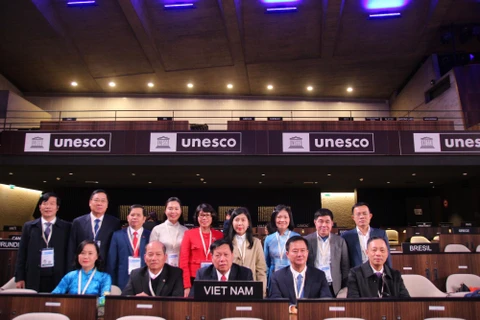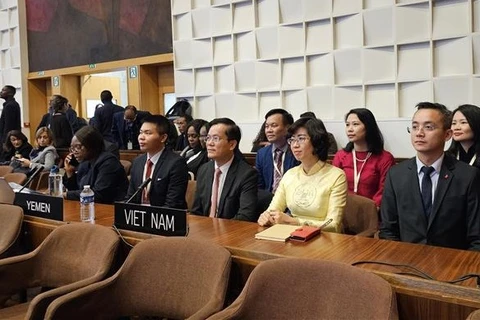Hanoi (VNA) - More than ever, Vietnam is proud of its huge heritage list of titles recognised and admired by the world, yet it requires both responsibility and knowledge to preserve those sites.
Last month, after nearly a century of "travelling" in France, the golden seal "Hoang De Chi Bao" (Treasure of the Emperor) returned to Vietnam with a hand-over ceremony held at the Vietnamese Embassy in the European nation on November 16.
A few days later, also in Paris, Vietnam was elected a member of the World Heritage Committee for the 2023-2027 term with the highest number of votes in the Asia-Pacific.
It must be noticed that the run to win a seat at the 21-member committee is not easy as it is one of the most important executive agencies of the United Nations Educational, Scientific and Cultural Organisation (UNESCO).
The committee is entrusted to decide on key issues related to the recognition of world cultural and natural heritage, and review and evaluate conservation efforts globally. It also decides on policies, budget, guidelines, and development orientation of the World Heritage Convention, which sees largest number of UNESCO members with 194 countries.
Obviously, this is important in many aspects, affirming the sound foreign policy adopted by the Vietnamese Party and State in line with the spirit of the 13th National Party Congress and Directive No. 25-CT/TW of the Party Central Committee’s Secretariat. The policy focuses on multilateralisation and diversification of relations, comprehensive and intensive international integration, promoting and advancing multilateral diplomacy, and concertedly implementing and effectively combining political, economic and diplomacy, and bilateral and multilateral diplomacy.
 The Vietnamese delegation to the 24th session of the General Assembly of States Parties to World Heritage Convention. (Photo: MoFA)
The Vietnamese delegation to the 24th session of the General Assembly of States Parties to World Heritage Convention. (Photo: MoFA) The high votes also demonstrate Vietnam's reputation in the international arena, and the confidence and support of the international community in the country’s contribution and management capacity at global multilateral institutions. They recognise Vietnam's practical contributions to relations with UNESCO, as well its efforts in preserving, conserving, and promoting heritage values.
Pride, responsibility and knowledge
Also in November, the urban project in UNESCO-recognised Ha Long Bay in the northern province of Quang Ninh that encroaches on a protected area has stirred up public opinion. Experts said the construction right on the coast is among the reasons behind waste floating into the bay.
Vietnam boasts 22 world heritage elements, including three natural heritage sites, 15 cultural heritage elements and four documentary heritage examples.
 At the site of the urban project in Quang Hanh ward, Cam Pha city, Quang Ninh province. (Photo: VNA)
At the site of the urban project in Quang Hanh ward, Cam Pha city, Quang Ninh province. (Photo: VNA) Preserving the existing values is more important than seeking more titles. Furthermore, the pride and responsibility do not allow heritage to be traded for economic benefits.
According to Quang Ninh Newspaper, education about Ha Long Bay has been conducted among young people. Since 2017, the People's Committee of Ha Long city has compiled a set of documents on Ha Long Bay preservation and education, which will be included in curricular at all primary and secondary schools in the locality. The move aims to raise students understanding about and awareness of the values of landscape, geology, and geomorphology to join efforts in preserving and promoting the heritage’s values.
In 2002, Hung Thang Primary and High School (Ha Long City) also began to integrate documents on Ha Long Bay preservation, compiled by the provincial Department of Education and Training, the Ha Long Bay Management Board, the marine conservation programme, and Fauna & Flora International, into its curriculum. Accordingly, its first graders have learnt about the legend of Ha Long Bay, while pupils from second to fifth grades have been equipped with knowledge about caves, mangroves, corals, fish, limestone mountains, tourism, waste, and waste treatment there.
The information seems quite methodical and complete, but it reminds of the issue of "relics and the burden of titles" as localities have been racing for recognition. Relics, like heritage, contain natural, historical and cultural deposits. However, if attention is only paid to ranking and recognition without measures to preserve and restore the relics, the consequences are significant.
Specific strategy needed
Harmonising and detailing legal corridors for heritage is also an issue that needs more attention. At a number of recent conferences, the issues regarding regulations on managing buffer and core zones, and adjacent areas of heritage have been raised.
Many experts held that there should be Government provisions detailing the protection of original elements that constitute heritage, relics and landscapes. Specifically, Ha Long Bay has been recognised by UNESCO for its aesthetic value, yet neither environmental impact assessments nor other reports mention it. The recognition of geological value must also clearly stipulate the original elements of the heritage from which the factors to evaluate impacts on the heritage must be displayed.
The phenomenon of sea reclamation in Ha Long reminds a similar story about the legal corridors for preserving heritage treasures in the event of the return of the golden seal "Hoang de chi bao" to Vietnam. This success affirms the cooperation between the State and the private sector to repatriate Vietnamese antiques which are now held around the world. The Vietnam Heritage Law (issued in 2001, and effective from January 1, 2002, and currently in the process of being revised) is believed by many experts to promote social interest in antiques lost. However, cooperation between the State and the private sector still needs a specific, long-term strategy to research and compile statistics on Vietnamese antiques that remain abroad.
By the end of 2022, Vietnam counted 27 additional national treasures, bringing the total number to 250, including many kept in private collections. The reality has proven the role of individuals in repatriating antiquities. The golden seal, for example, was purchased by Nguyen The Hong's family in Bac Ninh from Millon, the French auction house, for 6.1 million EUR (more than 153 billion VND).
Better late than never
The conference - workshop seeking feedback on the dossier of the draft Cultural Heritage Law (amended), organised by the Ministry of Culture, Sports and Tourism in Hanoi on November 13 and other sites across the country, attracted the participation of a large number of managers, scientists and cultural researchers.
Joint efforts protecting national cultural heritage elements have reached a number of important achievements over the past more than 20 years. These are recognised by the Party, State, people, and the world. They contribute to promoting traditional cultural values, strengthening national unity bloc, ensuring social progress and equality, improving living standards, and ensuring harmony between economic, cultural, and social development.
Participating experts agreed on the mechanism to mobilise and attract social resources to actively participate in protecting and promoting cultural heritage values.
British Council research experts implementing the Connecting Heritage programme, a Vietnam-specific version of the “Cultural Heritage for Inclusive Growth” project, point out that additional initiatives are needed to encourage and promote the voluntary spirit to take actions for cultural heritage in the community. Another solution is to promote communications on the important role and capacity of local people in preserving the cultural heritage that belongs to them.
To protect heritage, it is a must to consider the community as the centre. Protecting people who value heritage is crucial to building a comprehensive society and improves resilience and sustainability for the future./.























